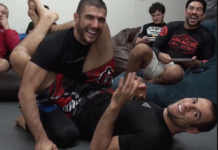The term BJJ archeology is one coined by Matt Thornton. Matt is one of the top BJJ coaches out there, and the man behind the world-famous SBG academy. His take on BJЈ archeology is to dig deep into the past of both Brazilian JIu-JItsu and other grappling martial arts to figure out answers to modern questions. While it may sound like looking back won’t help you deal with modern problems, the opposite is true. There are different ways of becoming a BJJ Indiana Jones, from old articles and books, to talking to some of the great grapplers of the past. However, nothing beats looking at old grappling videos. And, the older they are, the better.
I turned to BJJ archeology originally when trying to figure out leglocks. I had no idea what I was doing, I just knew I had to find a way to learn what the Danaher Death Squad guys were doing. Mind you, at this time, Danaher didn’t have anything in DVD format, and information was scarce. Some of the usually available leg lock DVDs didn’t’ really cut it. So I decided to do what Danaher did – explore everything there was about leg locks, trying to figure them out. Old grappling videos from Judo аnd Sambo that were not easy to find proved to have lots of answers to my questions. Later on, I decided to use the same method to clear up other aspects of BJJ. It hasn’t failed me so far.
What Is BJJ Archeology?
I really love the term BJJ Archeology. When you try it, you’ll understand why it really is similar to archeology. First up, digging up old stuff on a specific grappling subject is no easy thing. Yeah, the internet has lots of things, but not everything is easy to find. The digging you’ll be doing will be online as opposed to picking up a shovel, but it will be no less exhausting. And dealing with the findings will require the fine touch of an archeologist and his/her brush too.
When I say old grappling videos I mean old. Nothing newer than a VHS tape will do. Luckily, lots of the VHS stuff has been transferred to digital format. The quality is horrible, of course, but at least you can access it. Moreover, once you have an area of grappling you want to explore, like me with the leg locks, try and go as far back as possible. Ashi Garami is a Japanese term meaning leg entanglement, and it originates in Judo. That was a great pointer where to look. Digging up old, black and white Japanese videos on the subject was not easy, but it did end up helping me figure lots of things out.
The same happened when I realized that not all positions the DDS used were Judo based. I turned to Sambo to learn about the saddle, and once again, it was really old, although not black and white, Russian videos that shed more light on the subject.
Form there on BJJ archeology has become a huge tool, not just for me, but also for people in my academy. The trick here is going really deep and not brushing anything aside. So far, I’ve learned things about guillotine chokes, the front headlock, pinning, etc that I doubt anyone would’ve been able to teach me directly. Plus, you earn a brand new skill – learning how to dig deep into the internet to find the most forgotten grappling videos that can change your game.
How Can Old Grappling Videos Help Your Game
The biggest problem with old grappling videos is not digging them up, as hard as that can be. The biggest problem is figuring out how to learn from them. Try playing an old VHS recording, ripped to a CD, then transferred to a digital format on a modern HD screen. Not fun. Not to mention the sound quality, if you manage to get your hands on a video that is in a language you understand.
If you want to learn through BJJ archeology, though, you’ll need to lower your expectations. The older the videos, the worse the quality is going to be. Moreover, those grappling videos are not organized like modern BJJ DVDs. Thre’s no clear order of things, and sometimes you might only get a few minutes worth of useful material out of hours of tape. You’ll need to be patient and try to look at not just the details begin demonstrated, but the bigger picture. Look how they position themselves, look for tiny adjustments they make, look at how the Uke reacts to holds or positions. Those are all things that will help you figure out how to use the material you’re watching.
Also, be prepared to learn without sound. Most of the oldest videos come in Japanese or Portugues, in the case of BJJ. There’s also Russian as well, and even some greek videos if you go down the wrestling route. I had to get a VHS player to be able to watch some of the stuff that hasn’t been digitalized as well. That’s next level BJJ archeology, but it will provide you with answers to everything, even on how to pass stuff like the worm guard, or shut down Berimbolos. You just need to be creative.
Things Don’t Get Old, They Get Forgotten
The reason these really old moves work I because they’ve been forgotten. Brazilian JIu-JItsu is a fairly new martial art, and yet, it already has tons of things that have fallen behind as the art evolves. Leg locks, the closed guard, the grapefruit choke are just a few examples of things that are forgotten, but far from useless in modern grappling. Quite the contrary.
The same holds true for the moves that are older than BJJ itself. Digging up old grappling videos means you’ll see things that are not being done anymore. That doesn’t mean they are useless. Actually, these moves that are considered old, or in the case of Judo, illegal, are actually moves that are perfect for Jiu-Jitsu. AS Judo turned into a sport, many things fell behind, only taught in some schools as parts of belt exams. However, in the Judo of old, which stemmed directly from Japanese Ju-Jitsu, these moves were extremely effective. It is not too hard to figure out how to adopt some of these moves to your BJJ game and be able to surprise everyone.
A useful hint if you’re trying to improve your submission game is to do some BJJ archeology in the direction of catch wrestling. Don’t just look for old instructionals on catch wrestling, but try and see some of the oldest matches as well. The knowledge you can extract is immense, and you’ll soon start pulling off things like scissor chokes and hammer locks even on black belts. These moves might be forgotten, but they’re certainly not too old to work!
All In All
You can learn Brazilian Jiu-Jitsu literally anywhere. From watching a couple of pandas play around on National Geographics, to digging up ancient grappling videos of Japanese Ju-Jitsu demonstrations. BJJ archeology is a really fun way of unearthing things that can affect your game at all levels, from insignificantly to completely changing your grappling approach. In any case, you’ve got nothing to lose.












































